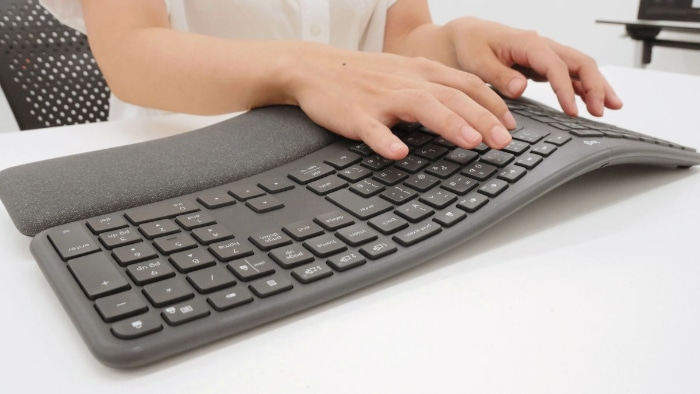Are Ergonomic Keyboards Worth It? Costs vs. Benefits

Feeling the aches and strains after a day at the keyboard is no stranger to many of us. In response, the tech industry offers an intriguing solution: ergonomic keyboards.
Designed to minimize discomfort and maximize efficiency, they have piqued the interest of many. But the lingering question remains: do they merit the buzz and, more importantly, the investment?
What Are Ergonomic Keyboards?
Ergonomic keyboards have emerged as specialized input devices designed to optimize human-computer interaction. These keyboards claim to minimize strain, improve typing speed, and foster overall comfort during extended periods of use.
Defining Ergonomic Keyboards
Ergonomic keyboards differ from standard keyboards in their form and functionality. While traditional keyboards have a flat and straight design, ergonomic models typically feature a contoured or split design to align more naturally with the human hand.
This way, the keyboards reduce the amount of wrist twisting, also known as ulnar deviation, and encourage a more natural hand and arm posture.
Design Philosophy
The principle underlying the ergonomic keyboard design is one of natural alignment. The aim is to create a typing environment where your hands, wrists, and arms rest in a neutral position.
This ‘neutral position' minimizes the stress and strain on the muscles and tendons, potentially reducing the risk of injury over the long term.
Key Features of Ergonomic Keyboards
- Split Design: One of the most noticeable features is the division of the keyboard into two halves. This promotes a more natural hand position while typing.
- Negative Tilt: Some models offer a negative tilt feature, angling away from the user, to keep wrists in a neutral or downward position, thus reducing strain.
- Palm Rests: These are padded areas for the palms to rest, offering support and reducing pressure points on the wrist.
- Adjustable Heights and Angles: Many ergonomic keyboards allow you to adjust the height and angle, providing a more customized and comfortable typing experience.
- Key Arrangement: Ergonomic keyboards often have keys arranged in a non-linear fashion, sometimes in columns rather than rows, to match the varying lengths of your fingers.
- Mechanical Switches: While not exclusive to ergonomic keyboards, mechanical switches offer better tactile feedback, potentially increasing typing speed and accuracy.
The Science Behind Ergonomics
Ergonomics is the interdisciplinary field that focuses on optimizing the relationship between people and the systems they interact with, such as workstations or devices. In the context of keyboards, ergonomics aims to create designs that minimize physical discomfort while maximizing efficiency.
Principles of Ergonomics
Ergonomics is rooted in various scientific disciplines, including biomechanics, psychology, and industrial design. One primary goal is to eliminate awkward postures and motions, which can lead to discomfort and injury over time.
For keyboards, these principles manifest in design features aimed at achieving natural wrist alignment, reducing muscle strain, and fostering a more comfortable typing experience.
Evidence from Scientific Studies
A considerable body of research examines the effects of ergonomic keyboards on health and productivity. Studies have shown that using ergonomic keyboards can significantly reduce muscular discomfort and the symptoms of repetitive strain injuries (RSIs), such as carpal tunnel syndrome.
However, the degree of benefit can vary from person to person and may also depend on the particular design of the ergonomic keyboard in question.
Biomechanical Considerations
Biomechanics, a subset of ergonomics, focuses on the mechanical aspects of human movement. When it comes to typing, biomechanics looks at the forces exerted by fingers, wrists, and arms, and how a keyboard's design can alter these forces for the better.
Features such as key resistance, key placement, and keyboard angle all play roles in either increasing or decreasing biomechanical strain.
Ergonomics and Productivity
While the primary focus of ergonomic keyboard design is often on physical well-being, there is also evidence to suggest that it can affect productivity. An ergonomic layout can facilitate a more fluid typing motion, which could lead to faster typing speeds and reduced error rates.
Additionally, comfort and reduced fatigue can also contribute to increased mental focus and overall productivity.
Psychological Effects
It's worth noting that ergonomics doesn't just affect the body; it also has a psychological component. A well-designed, comfortable workspace can improve mood and job satisfaction, which in turn can have a positive impact on performance and productivity.
While hard to quantify, the psychological benefits of using ergonomic equipment should not be overlooked.
Benefits of Using Ergonomic Keyboards

Switching to an ergonomic keyboard promises a range of benefits designed to enhance your typing experience, reduce discomfort, and promote overall well-being. This expectation isn't solely based on marketing claims but is often substantiated by user testimonials and scientific studies.
Physical Comfort and Reduced Strain
One of the most immediate benefits of using an ergonomic keyboard is an increase in physical comfort. By promoting a more natural hand and wrist position, these keyboards reduce the likelihood of strain or discomfort.
Several users report experiencing less tension in their wrists and shoulders, leading to longer and more comfortable periods of typing.
Enhanced Typing Speed and Accuracy
Ergonomic keyboards are designed not only for comfort but also for efficiency. The unique key arrangements, tactile key switches, and other design features can contribute to an increase in typing speed.
Furthermore, the more natural hand positions may reduce the number of typing errors, contributing to overall productivity.
Long-term Health Benefits
Using an ergonomic keyboard may offer long-term health benefits by reducing the risk of developing repetitive strain injuries like carpal tunnel syndrome. Prolonged computer use with a traditional keyboard can lead to such conditions, but ergonomic keyboards aim to minimize these risks by providing a more anatomically friendly design.
Psychological Advantages
While perhaps less immediately evident, the psychological benefits of ergonomic keyboards should not be discounted. A comfortable workspace can improve mental well-being and may even reduce stress and anxiety.
In turn, this can contribute to better focus and productivity, forming a virtuous cycle of well-being and efficiency.
Customizability and Adaptability
Many ergonomic keyboards come with a range of customizable features, from adjustable tilt angles to programmable keys. This level of customization allows users to fine-tune their typing experience according to their unique needs and preferences.
Adaptability is particularly useful for those with specific physical limitations or unique workspace configurations.
Common Criticisms and Drawbacks
While ergonomic keyboards offer a range of benefits, they are not without their criticisms and drawbacks. The features that make these keyboards advantageous for some might present challenges for others.
Initial Cost Investment
One of the most frequently cited drawbacks is the initial cost of ergonomic keyboards, which can be significantly higher than their standard counterparts. The pricing often reflects the research and technology that go into these specialized devices.
However, users on a budget may find the upfront investment prohibitive.
Learning Curve and Adaptation Period
Switching from a traditional to an ergonomic keyboard often requires a period of adjustment. The split design and different key layouts can initially slow down typing speed and may even increase the error rate.
This adaptation period can be frustrating for users who need to maintain high productivity levels.
Not One-Size-Fits-All
While ergonomic keyboards aim to provide a more natural typing experience, the term ‘ergonomic' is not universally defined. Different models offer different features, and what may be comfortable and efficient for one person could be unsuitable for another.
This makes choosing the right ergonomic keyboard a complex task that might require trial and error.
Limited Portability
Ergonomic keyboards, especially those with more intricate designs or additional features like palm rests, can be bulkier than standard keyboards. This may limit their portability, making them less ideal for those who frequently work from different locations or require a more streamlined setup.
Compatibility Issues
Some ergonomic keyboards come with specialized software for customization or are designed to work optimally with certain operating systems. While these features offer added benefits, they can also result in compatibility issues that might limit the utility of the keyboard across different platforms or devices.
Workspace Aesthetics
This may seem trivial, but the unique design and larger footprint of some ergonomic keyboards might not align with every user's aesthetic preferences or workspace constraints. As a result, the look and feel of these keyboards could be a potential downside for those who value a particular aesthetic.
Comparing Costs and Benefits
The decision to invest in an ergonomic keyboard ultimately boils down to a comparison between its costs and benefits. Given the mixed opinions surrounding ergonomic keyboards, a comprehensive assessment can help you make an informed choice.
Short-Term Costs vs. Immediate Benefits
The initial cost of an ergonomic keyboard can be a deterrent, especially when high-quality models can range from $50 to upwards of $200. However, the immediate benefits—reduced strain, increased comfort, and potentially faster typing speeds—might justify the expense for those who spend significant time at the keyboard.
Some users report immediate relief from wrist and hand discomfort, making the short-term costs worth considering.
Long-Term Investment vs. Health Benefits
Over extended periods, the cost of an ergonomic keyboard can be amortized against the potential health benefits. Reducing the risk of repetitive strain injuries or conditions like carpal tunnel syndrome can save on future medical expenses and lost work time.
It's a scenario where an upfront investment can yield long-term returns in the form of better health and potentially reduced medical bills.
Adaptation Time vs. Productivity Gains
While the adaptation period to a new keyboard layout can affect short-term productivity, it's worth contrasting this against the long-term gains in speed and efficiency. Over time, the ergonomic design may lead to faster typing speeds and lower error rates, effectively compensating for the initial period of adjustment.
Customization Expenses vs. Individual Comfort
Some ergonomic keyboards offer advanced customization options, such as programmable keys and adjustable angles, which might come at an additional cost. These features allow for a more personalized typing experience and can significantly enhance comfort, making the extra expense justifiable for some users.
Aesthetics and Portability vs. Functional Benefits
Although ergonomic keyboards may compromise on aesthetics and portability, these are often secondary concerns when balanced against functional benefits like comfort and reduced strain. Users will need to decide whether the ergonomic advantages outweigh any issues related to appearance or mobility.
Conclusion
Ergonomic keyboards present a compelling blend of advantages and challenges that warrant thoughtful consideration. From the scientifically backed design principles aimed at enhancing physical comfort to the psychological benefits of a well-considered workspace, these specialized keyboards offer a multifaceted approach to improving the typing experience.
However, it's critical to acknowledge the legitimate criticisms and drawbacks, such as the initial financial investment, the adaptation period, and the varying effectiveness depending on individual needs.
In weighing these factors, a comprehensive cost-benefit analysis can provide invaluable insights. Whether the focus is immediate comfort, long-term health benefits, or enhanced productivity, the decision to switch to an ergonomic keyboard should be based on a balanced evaluation of these elements.
Given the time many of us spend at our keyboards, this is not a trivial choice but one that could have lasting implications for our comfort, health, and overall well-being.


